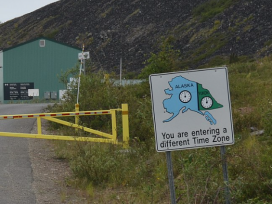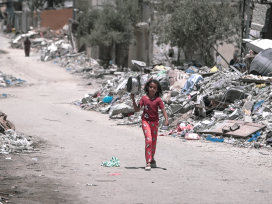Almost two years after the onset of the pandemic, young people in Europe are reflecting on the impact it has had on their lives and questioning what it will mean for their future prospects.
‘I was afraid about my career before the pandemic … now it’s even harder’. These words, which capture some of the concerns widely felt by young people in the wake of the pandemic, come from one of the many young voices featured in a study recently published by the European Youth Forum entitled Beyond Lockdown: The Pandemic Scar on Young People. It examines the impact of the health crisis on young people’s employment, education and mental health and considers the long-term implications.

Punch, Lily McLeod, Glasgow School of Art, image via Flickr
The research was based on survey responses from 4,500 young people in Europe and focus groups in which young people shared their experiences of the pandemic. The focus groups involved 25 young people in marginalized situations across 10 European countries, including young people with disabilities, young refugees and migrants, young Roma, rural youth, and young people in precarious employment situations.
Their stories illustrate how the working lives of young people have changed dramatically during the pandemic, with many losing their jobs. ‘Students were the first to get fired,’ explained one respondent, ‘because the owners were more keen on firing young people than those who are in higher functions, or management.’
Not only are young people at greater risk of losing their jobs, but the labour market situation meant they often have no choice but to accept whatever conditions are offered by their employers. Another respondent said: ‘I have a job for 50 percent [of my time]. My big fear is that if they want to extend my contract, I cannot say no […] If I say no to this, I’m not sure if I can get anything else.’
Many of the young people currently looking for work or finishing their studies expressed that they no longer felt they could follow their career dreams and must instead ‘focus on a job that will give me money to live’. This left a lot of young people with the sensation of taking steps backwards in their lives. ‘I don’t think it’s fair that we have young people approaching 30 years old who have to move back with their parents,’ said a respondent, ‘this is happening a lot right now, but also before the pandemic.’
Pre-existing inequalities have been magnified
Policy-makers often tend to treat the young as a singular, homogenous group, forgetting that the experiences of young people vary strongly, often according to other personal characteristics, such as ethnic background, gender, sexual orientation, religion. Combined with a young age, these characteristics can result in additional barriers, and the pandemic has been a striking reminder of this.
The short and long-term impacts of COVID-19 will undoubtedly be much more profound and long-lasting for those young people in marginalized situations. Yet too often such nuances are not taken into account in the analysis of the pandemic and the response.
One young refugee who took part in a focus group explained how their community had been particularly affected by the impact of COVID-19:
In the refugee community [in my country] one of the problems is that people don’t have enough money. So with everything switched to online, families with maybe five children or four children that are in school are hopping on your Mum’s one phone … to be able to have access to online education. So that means these young people have to rotate. Today I go online, tomorrow you go online; for me that is not an effective way of learning.
Furthermore, young people with an immigrant background and young Roma told us that they were unaware of any government support available in their local communities and felt that those in ‘rich white neighbourhoods’ would be much more likely to have access to government support.
Young people in marginalized situations have borne the brunt of the employment crisis, being twice as likely as other young people to have lost their jobs during the pandemic. There is also evidence of important gender differences when it comes to the impact of COVID-19. Young women (12.9 percent) were more likely to have stopped working than young men (9.8 percent) and 73.2 per cent of young women reported possibly or probably having anxiety or depression compared to 54.1 percent of young men.
The impact of the pandemic, therefore, seems to have magnified pre-existing inequalities and demonstrates the importance of taking an intersectional approach to recognize the different challenges faced by different groups of young people.
A mental health and unemployment crisis
The statements from young people show that many are seriously discouraged about what the future holds for them. When asked about their future career prospects, half viewed them with uncertainty and more than one in 10 felt fearful. The research also shows that there is a clear connection between the dire labour market situation and young people’s mental health, with the survey responses showing that 65 percent of young people possibly or probably have anxiety or depression.
High rates of unemployment and a lack of job security for young people in precarious work leaves them with very little stability and puts them at risk of poverty. Moreover, disruption to education and a lack of job vacancies means many young people are reconsidering their long-term career future, including possible delays to important life milestones such as owning their own home or starting a family.
This will be a significant driver of anxiety and depression among young people, and there is likely to be a circular effect with poor mental health negatively impacting young people’s performance at work as well as their chances of finding a job.
This comes as no surprise when we look at the extent of the impact on young people’s employment. Since the onset of the pandemic, it is estimated that the youth unemployment rate in the EU has risen from 14.9 percent to 17.1 percent, an increase three times higher than for the total working population. Some member states have seen youth unemployment rise dramatically higher than others, with Estonia, Lithuania, and Spain seeing youth unemployment rise by 10 percentage points or more between December 2019 and December 2020.
A deeper and more long-term impact
Although alarming, the unemployment statistics may be merely the tip of the iceberg when it comes to the actual number of young people out of work. In the first half of 2020, there was an increase of 3.2 million to the number of people who were unemployed but not seeking work in the EU (many of which are likely to be young people).
As they are classified as ‘inactive’, these people are excluded from unemployment statistics, but they represent 86 percent of the total decline in the employment rate in the EU. The true impact of the crisis on the labour market is therefore much deeper than suggested by the unemployment statistics.
Whether young people will be able to quickly return to the labour market once the economic recovery begins remains to be seen but, worryingly, a key ingredient for preparing young people for this is missing. Among young people who were not in education, employment, or training, 49 percent said they were unaware of support services from the government to help them find a job according to the survey responses, and less than one in four reported that they were receiving income support such as unemployment benefits.
A failure to reach out and support young people greatly increases the risk of leaving young people exposed to poverty and a longer-term ‘pandemic scar’. Previous research demonstrates that experiencing periods of unemployment during youth leads to much greater chances of future spells of unemployment, lower income, and poorer health and wellbeing.
An avoidable crisis?
It would be misguided, however, to expect the recovery of the economy and labour market and a return to normal to miraculously solve this potential pandemic scar. Young people already faced structural issues before the pandemic which made their transitions from school to work difficult, with many stuck in precarious work and unable to access quality jobs that could provide them with the security to lead an independent life.
This is reflected in high rates of temporary work among young people with 47.8 percent of young workers (age 15 – 24) in the EU employed on a temporary basis compared to 13.5 percent for the overall workforce. Young people are also over-represented in other non-standard forms of employment such as platform work or zero-hour contracts. The crisis has exposed just how little security these types of jobs provide.
Part of the blame for this lies with the reaction to the 2008 crisis where policy-makers implemented measures to promote ‘any job’ for young people to reduce rates of youth unemployment. Young people’s rights to fair pay and decent working conditions were sacrificed to boost employment rates through the promotion of precarious jobs such as unpaid internships or the introduction of lower youth minimum wage rates. This approach has clearly backfired, with precarious jobs becoming a dead-end for young people rather than a bridge to a quality job, with many stuck in cycles of low-paid temporary work.
Making young people a priority
Have policy-makers learned from the mistakes of the 2008 crisis? Analysis of national employment and economic policy measures reveals that out of 1,283 policy measures introduced in the EU and the UK, only 12 specifically targeted young people. The research also found that no policy responses have been introduced to support young people’s mental health. Despite bearing the brunt of the social impact of the crisis, the youth appears to have been largely overlooked.
However, there were some examples identified of youth-focused interventions at the national levels. In Portugal, the ATIVAR programme introduced financial incentives to encourage employers to hire young people, with a focus on permanent contracts.
In addition, Portugal is one of the EU member states that has been working closely with youth organisations to update their Youth Guarantee Implementation Plan [more on the youth guarantee below] and supported a stronger social dimension in their EU presidency. Its achievements included the Social Summit in Porto in May 2021, where the European Pillar of Social Rights Action Plan was endorsed.
In the Netherlands, a 1.4 billion euro social package has been introduced, with significant provisions for addressing youth unemployment. A key part of the initiative is focused on preventing school leaver drop-out and providing young people with opportunities to extend their education. These measures have the potential to mitigate the disruption to education experienced during the pandemic and support young people to gain new skills, helping them gain access to the labour market as the economy recovers.
As for the EU level, it remains to be seen whether measures will be able to address the crisis. The Reinforced Youth Guarantee was adopted in 2020, providing an opportunity to scale up efforts to support youth employment. The Youth Guarantee provides a policy framework for improving support to young people out of work and aims to provide an offer of employment, training, or education within four months of becoming unemployed or leaving education. Its implementation is underpinned by EU funds for national governments to scale up support services for young people.
However, over the years, the Youth Guarantee has been subject to criticism for the lack of quality jobs that it provides. Many offers have been for low or unpaid temporary positions which provide no long-term route out of unemployment and instead fuel the trend of precarious work. The Youth Guarantee has also often benefited more advantaged young people, as the initiative struggled to reach those in more marginalized situations and lacked the necessary investment to properly tackle the complex challenges they face.
The Reinforced Youth Guarantee is an opportunity to address these issues but it is unclear how much progress has been made by member states so far. One key issue is that, despite the impact of the pandemic on youth employment and the potential of the Youth Guarantee to address some of these challenges, the European Commission has not asked member states to introduce new implementation plans to take into account the Reinforcement.
The Commission and Council have also not acted on calls from youth organisations, trade unions, and the European Parliament to introduce binding quality standards for the Youth Guarantee, which would ensure that young people receive secure and well-paid jobs.
The funding available under Next Generation EU, particularly through the Recovery and Resilience Facility (RRF), is another important opportunity for supporting measures for young people, especially considering that one of the pillars of the recovery fund is ‘the next generation’. However, youth organisations report that they have largely been sidelined in the creation of the national recovery plans, casting doubt on how much youth will be prioritized.
The ambition to ‘build back better’ has been shared by many political leaders. Yet, young people across Europe are still waiting for measures that genuinely tackle the structural issues which leave them trapped in precarious work and vulnerable to unemployment. An effective response must be based on quality jobs, access to mental health support, and tailored solutions for young people in marginalized situations. The price of inaction on these issues could be a lasting scar for decades to come.
This article was first published by Green European Journal on 30 August 2021.
Published 10 January 2022
Original in English
First published by Green European Journal
Contributed by Green European Journal © William Hayward / Green European Journal / Eurozine
PDF/PRINTIn collaboration with
In focal points
Newsletter
Subscribe to know what’s worth thinking about.
Related Articles

Clock times and social times conflict across much of Europe. Timekeeping is a deeply political matter, and João Lipinsky Nunes of Better Times takes issue with them.

The Active Amputee blog’s Björn Eser believes that the way we go about prosthetics should change. He’s a lover of the outdoors, even more so since his amputation, but he takes issue with the limits of social and medical support for disabled people.






